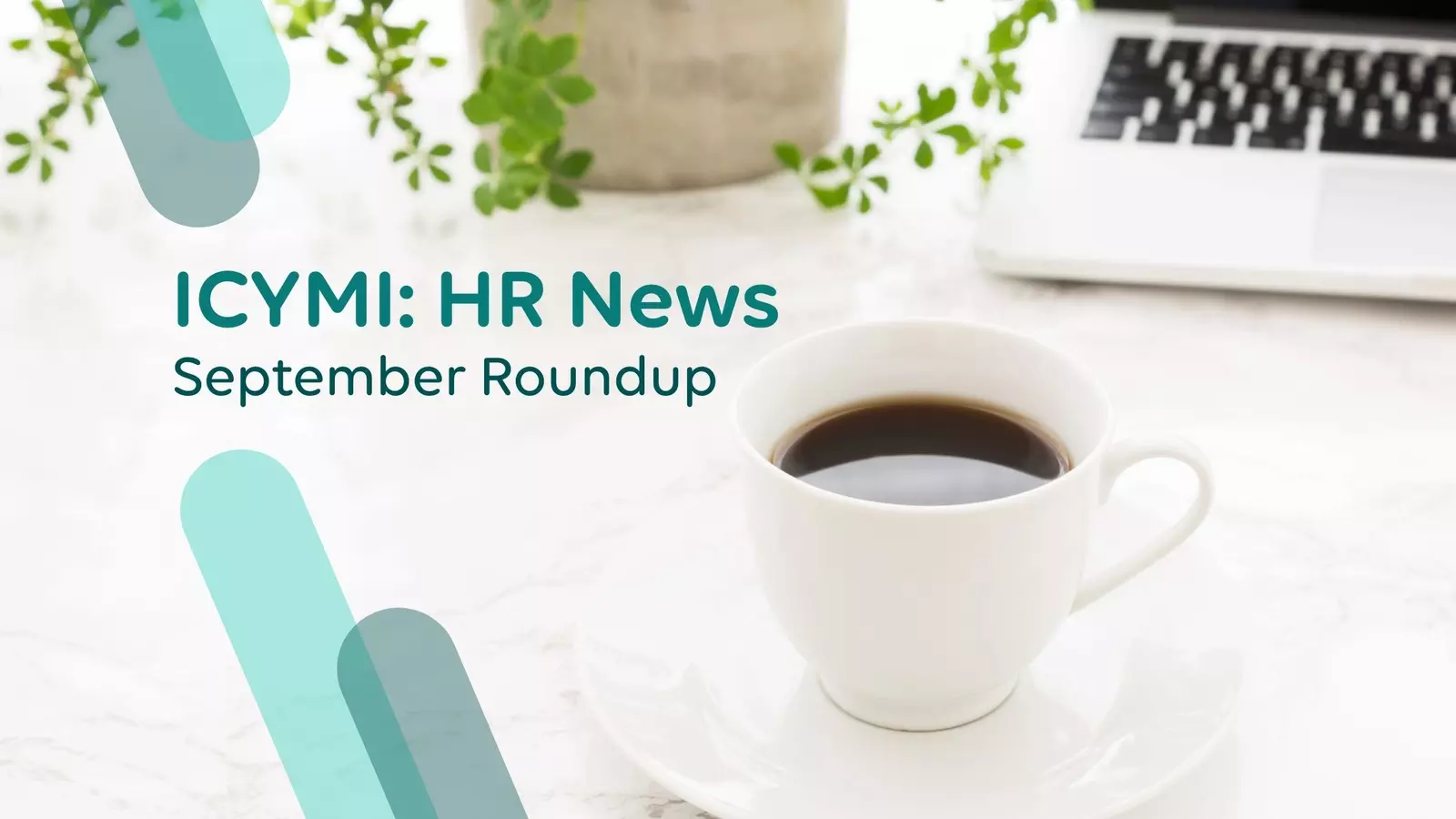The world of work moves fast and keeping up can be a challenge. That’s why UKG invests in dedicated teams of workforce researchers, social scientists, futurists, and data analysts to ensure we continue to serve our customers as strategic business partners. We believe that insight into current events and emerging trends is critical to business continuity and agility, and that HR leaders are often too busy to keep up with daily newsletters. We’re here to help.
In this “HR News You Can Use” series, we unpack the top takeaways from the month in a digestible, easy-to-read format. Here are the top updates from September.
1. U.S. panel recommends anxiety screening for all adults under 65
Earlier this month, the U.S. Preventive Services Task Force (USPSTF)—a panel of medical experts appointed by the federal Department of Health and Human Services—released its draft recommendation that doctors screen all their adult patients for anxiety. These recommendations heavily influence the standard of care among primary care physicians, and similar recommendations have resulted in universal mental health screenings for pregnant and postpartum women (who are significantly more likely to develop mental health disorders).
This guidance comes as a flurry of research illuminates the true scope of the mental health crisis. One in five Americans suffer from acute mental illness, and the World Health Organization found that COVID-19 increased the presence of global anxiety and depression by 25 percent in its first year alone. Suicidal ideation among adults has increased every year since 2011. Fifteen percent of young Americans have experienced a major depressive episode in the past year. And fatal drug overdoses rose nearly 15 percent in 2021, doubling in a six-year period.
Anxiety disorders are the most common mental illness in the U.S., affecting approximately 40 million adults every year. Anxiety disorders can often lead to, or worsen, other mental and physical conditions, such as depression, social isolation, problems functioning at school or work, insomnia, and substance abuse. Unfortunately, due to vague symptoms like fatigue and generalized pain, anxiety disorders often take years or decades to diagnose, if ever. (More than half of adults with mental illness never receive treatment.)
There is strong evidence that screening instruments work, and that follow-up interventions can reduce anxiety and improve quality of life. Standardized screenings could help millions of Americans detect and treat debilitating anxiety, and potentially other co-occurring disorders as well.
What this means for employers: Employers are hurting in this crisis, too. It’s estimated that depression alone costs employers up to $50 billion per year in absenteeism, presenteeism, and lost productivity. One survey estimates organizations spend an average of $15,000 each year for every employee experiencing acute mental health issues.
Obtaining an initial diagnosis from a primary care physician could encourage more employees to take advantage of employer-funded mental health benefits, which have been shown to provide a remarkable ROI of $4 for every dollar invested.
Yes, and: While mental health benefits are critical, it’s important to address the root cause: stress. Psychiatric science believes stress triggers nearly all mental disorders, so the best treatment is often helping people live less stressful lives. That’s nearly impossible to do in today’s world, as the compounding stressors of economic uncertainty, climate change, global and political unrest, and more compete for worry space.
What employers can do, however, is support the core areas of employees’ lives they influence. Paying a livable wage and providing support for retirement and emergencies. Offering meaningful benefits, including mental and physical healthcare. Providing career growth opportunities and ways to continue upskilling and reskilling. Protecting against burnout by setting reasonable goals and expectations and ensuring a positive culture is in place. Encouraging authentic relationships between team members and cultivating communities and supportive team connections.
2. 30-year mortgage rates hit 6.25%
Last week, Mortgage Bankers Association figures showed the average contract rate on a 30-year fixed mortgage jumped to 6.25%—a 14-year high that’s more than double the rates from a year ago. Adjustable-rate mortgages also increased 31 basis points, with the average five-year ARM reaching 5.14%.
This is yet another sign that the Federal Reserve’s continued interest hikes are having their desired effect on the economy. And while increased mortgage rates are making homes more expensive to buy, they’re also having a critical cooling impact on the red-hot U.S. housing market that’s been plaguing potential homebuyers for the past two years.
Last month was the first time since March 2021 that the typical home sold below its asking price, and contingencies such as appraisals and inspections—which have been almost unheard of in this market—are finally back on the table. Home sales dropped 19% year over year in July to their lowest level since the start of the pandemic, and the total number of homes for sale was up 4.2% year over year for August. It appears that supply and demand are slowly beginning to stabilize.
Why you should care: The housing market is classified as a leading economic indicator, which means that the housing sector tends to lead the broader economy both into and out of recessions. Declining real estate values have preceded every recession over the past 80 years with just two situational exceptions; like a canary in a coal mine, the housing market is worth listening to.
Conversely, GDP, unemployment, wage growth, and inflation are all lagging economic indicators. Here, too, we’re seeing evidence of the Fed’s desired “soft landing”—UKG’s latest Workforce Activity Report shows gradual declines in shift work volume in six out of the past seven months, yet no indication of widespread layoffs among the hourly workforce. (Register for UKG’s Live Labor Market Briefing for the latest update.)
What this means for employers: It’s clear that the labor market is mirroring trends in the housing market. Home sale prices are down 6 percent from their record highs in June, but they’re still 5.9 percent more expensive than they were a year ago. Turnover and inflation are trending down but are still near historically high levels, and unemployment is trending up, but there’s still 1.8 open job positions for every one person looking for work.
3. Chief Climate Risk Officer hired to oversee big banking
Earlier this month, the federal agency overseeing the country’s largest banks hired a chief climate risk officer to assess climate-driven risks to banks and determine how to manage them.
This announcement occurred as the summer of catastrophic climate events continued into September. California, Arizona, and Nevada suffered the most severe September heat wave ever recorded. Devastating flooding in Pakistan submerged more than a third of the country, affected 33 million people, and killed at least 1,300. Hundreds of thousands of Puerto Ricans are still without power, 10 days after Hurricane Fiona hit. Making its way north, Fiona earned the distinction as the strongest storm to ever hit Canada, causing substantial infrastructure damage from Nova Scotia to New Brunswick. And as I write this late Tuesday evening, Hurricane Ian has already left 11 million people without electricity in Cuba and is headed for landfall along Florida’s west coast.
Why do banks need a climate officer? These increasingly severe and unpredictable weather events make it challenging for banks to determine how much money to lend to real estate in various areas. There is also the concern that a disastrous weather event could cause outsize losses to several banks, threatening the stability of the entire financial system.
What does this have to do with employers? Climate-related events have already affected more than one in four organizations worldwide, and 89 percent of C-level executives surveyed by Deloitte agree there is a global climate emergency. Like banks, businesses face countless climate risks, from operational impacts like facilities damage and workforce disruption to supply chain disruption and insurance costs. And yet, hardly any companies are prioritizing climate contingency plans and climate-based operational changes into their long-term strategies.
The top obstacle cited for climate change preparedness and sustainability initiatives was a focus on near-term business demands. Indeed, 65 percent of executives said their organizations were forced to cut back on sustainability initiatives due to the pandemic.
Understandable; and: Prioritizing short-term over long-term is a big part of how we got into this mess.
Dive deeper: Heat waves, for example, are usually the deadliest type of weather emergency, and they’re rapidly increasing in frequency around the globe. As we’ve seen in California and other Western states, heat waves exhaust resources and can lead to widespread, long-lasting blackouts that make conducting business as usual impossible. More worrisome, heat exposure is currently one of the top three causes of occupational death in the U.S., killing an estimated 600 to 2,000 workers each year. Reports released last month predict that much of the U.S. will be in an “Extreme Heat Belt” by the 2050s, with heat index temperatures reaching well over 125 degrees Fahrenheit on a regular basis. Business leaders need to begin developing heat strategies for their organizations now, whether that means investing in wearable tech for on-site employees that can monitor core body temperatures or developing contingency plans for office workers who may lose power for days at a time.
Karina recently contributed stories on "quiet quitting" and the evolution of life and work.



